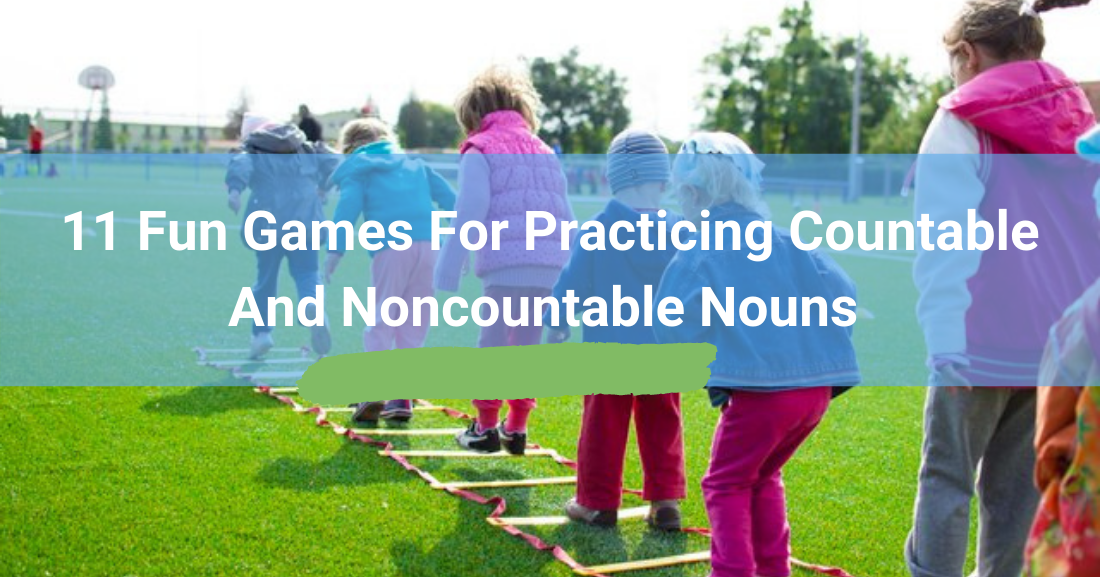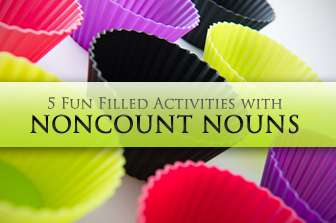You Can Count on Me: 11 Fun Games for Practicing Countable and Noncountable Nouns


The objects in English require a counting word to express plurality. For example, pieces of furniture, cups of coffee or cartons of milk. Once you explain the concept of noncount nouns to your class, here are some fun activities for reviewing how to properly express noncount nouns in English.

When you are teaching noncount nouns, you will find that many of them fall into the category of food. Rice, milk, coffee, jelly and peanut butter are just a few of the noncount nouns one might find at a picnic. Playing this game will challenge your students’ memories while also reviewing count and noncount nouns. Arrange your class in a circle. Then start the game by saying, “I’m going on a picnic, and I’m bringing a ________” filling in the blank with a food item, either count or noncount. The student to your left continues, “I’m going on a picnic and I’m bringing a…” He then chooses his food item and repeats your food item. The third person in the circle chooses a food item and repeats the other two. Play continues around the circle until it has reached you once again, and you face the big challenge of remembering what everyone is bringing on the picnic! As play moves around the circle, be sure to correct your students if they make an error with count and noncount nouns. For example, if someone says I am bringing a juice, you should remind him or her to say a bottle of juice.
Give each student two stiff cards. On one have her write much, and on the other have her write many. All students should hold their cards flat on their desks. You present a noun to them, and they need to decide whether they should use much (noncount nouns) or many (count nouns). On the count of three, each person holds up his chosen card. Anyone who gets the answer wrong is eliminated. Play until only one student remains – the winner.
Play a baseball style game with count and noncount nouns with your students. Draw a baseball diamond on the board or lay one out in your classroom (your students will not be running) and review the basic rules of the game. Then give each “batter” a fill in the blank challenge that includes a noncount noun. For example, you might write on the board “Five__________celery”. The batter must then choose which blank to fill in to correctly complete the phrase. In this case, “five stalks of celery.” If the batter gets the answer right, his team gets a hit and he advances to first base. If the batter gets the answer wrong, he is out. Teams give each member a turn until they receive three strikes. Anyone who makes it around the bases scores a point for his team. Play for three innings, and the team with the most points at the end wins bragging rights.
There is no risk in this game for practicing pluralization of noncount nouns. Write several noncount nouns on small slips of paper and put them in a hat or basket. Then give a student two standard, six sided dice. First she rolls the dice to get her number. Then she draws a noun. She must then make a sentence using the number to pluralize the noun she drew. For example, if your student rolls a seven and pulls the noun furniture, she could say, “I bought seven pieces of furniture this weekend.”
Play this classic youth group game with your ESL students to practice the difference between a and some in English. Students arrange themselves in a circle. Give one student an object (a pencil, for example). That student should then present that item to the student next to him. Their conversation should follow the following pattern.
The first student then passes the object to the second student, and that person follows the same pattern as he introduces the item to the next person in the circle. Play continues around the circle until the object is back to the first person. While this object is moving around the circle, give two other students additional objects and have them present them to their neighbors in the circle. You will have three objects travelling around the circle at the same time, and students will need to pay attention to what they are giving and receiving. If you are careful to choose at least one count noun and one noncount noun, your students will have to determine whether to use a or some in their dialogue. For example,
Listen to students as they present their objects and correct any errors you hear.
These fun filled activities give your students a chance to practice this unusual structure while having a good time in your classroom.
What are your favorite activities for reviewing noncount nouns?